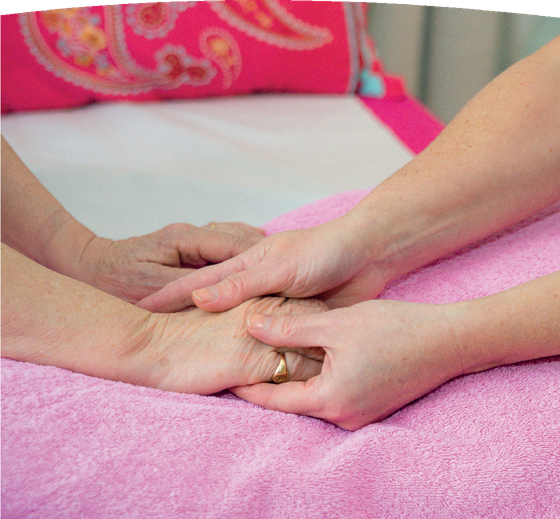Information for patients and carers
What are the benefits of a hand massage?
- Promotes relaxation
- Reduces localised pain
- Improves circulation
- Nourishes the skin
- Provides non-verbal communication and support
- Hands are easy to reach and there is none of the inconvenience of getting undressed.
Do not massage without medical advice:
- Broken and bruised skin
- Arthritic/tender joints
- Swelling
- Skin infections
- Areas of tumour
- Clinically diagnosed thrombosis.
Please read carefully before giving a hand massage
Important safety information – due to fire safety regulations only use water-based creams and lotions if the person receiving or giving the massage uses oxygen therapy.
What you will need
A lubricant is needed for massage. The skin of aged and ill people often does not absorb the oil well. A favourite hand lotion or cream with a drop of oil needs to be thin enough to glide well and feel smooth and soothing to the skin. You will also need:
- Towel
- Pillow
- Comfortable seat and working position
- Music (if appropriate)
- Consent from the receiver.
During treatment
All moves should be gentle, smooth and flowing. Check that the receiver is comfortable throughout the treatment. Gauge length of time; most treatments will be between 10-15 minutes.
Following treatment
Wipe residual oil off receivers’ hands; make sure they are feeling all right before attempting to move them. Wash your hands.
Routine – see leaflet for photos
Gain consent of the receiver, this can be verbal or non-verbal, a nod of the head will be enough. Ensure both you and the receiver are comfortable, warm and you have all you need for the treatment.
1. Solar plexus breathing
Take the hand palm upwards, supporting underneath. Placing your thumb in the middle of each palm (under the knuckle of the middle finger) ask your partner to take three breaths. Breathe with your partner and press into the palms on the in-breaths, releasing on the out-breath.
2. Hand and forearm stroke
Place about a teaspoon of the lotion or oil into your palm and rub gently between your hands to warm it.
Take your partner’s left hand in your left hand, placing your right hand on top gently stroke up the hand to the forearm, sweeping underneath and back down the arm to the palm. Then using your left hand repeat the move three times.
3. Wrist massage
Using both thumbs and supporting your partner’s hand, make circling movements with your thumbs around all the wrist bones three times.
4. Drainage stroke
Holding the fleshy part of your partner’s hand in both your hands, stroke the back of the hands, making fanning out movements with your thumbs from the knuckles to the wrist three times.
5. Finger relaxation
Holding your partner’s hand palm down, with the other hand work each finger separately; circling each joint three times, working down to the tip of the fingers.
Gently stretch each finger before giving a final stroke to the whole finger.
Change hands when you reach the thumb, massage a little more deeply and turn the hand over and support to massage the thumb pad.
6. Palm relaxation
Use thumbs to continue to make gentle circles over the whole of the palm area. Continue for 30-60 seconds.
7. Hand and forearm stroke
As before, repeat once with each hand and hold your partner’s hand in a ‘sandwich’ and gently slide off.
8. To finish
Take both hands again and repeat solar plexus breathing exercise. Hold the hands for a few moments and give a gentle squeeze to end the treatment.
Aftercare
Following a hand massage it is advisable to have a glass of water or herbal tea. It is best to avoid caffeinated drinks and alcohol.
You may feel drowsy or tired and sometimes experience a release of emotions after a treatment.
For further information or advice on complementary therapies, contact the Complementary Therapy Coordinator on 01823 333822 or 01935 709480.
Contact us
For further information or advice on complementary therapies, contact the Complementary Therapy Coordinator on 01823 333822 or 01935 709480.

